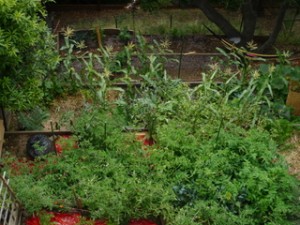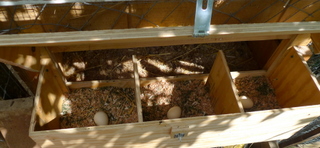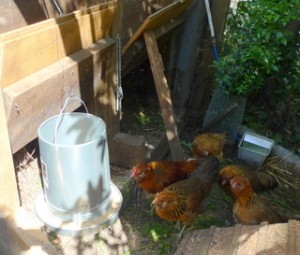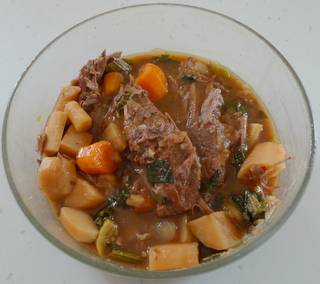Month: August 2011
You Ain’t Nothin’ but a Hound Dog
This morning’s NY Times had an obituary for Jerry Leiber, who along with Mike Stoller visited Johnny Otis as teenagers and heard Big Mama Thornton sing “Ball and Chain.” Inpired, they went home and wrote “Hound Dog,” in about 12 minutes and brought it back for Big Mama Thornton! The list of their songs reads like the contents of my teen-age brain. After reading the obituary, Larry brought out his autographed copy of the team with Elvis, the same photo featured in the obit:
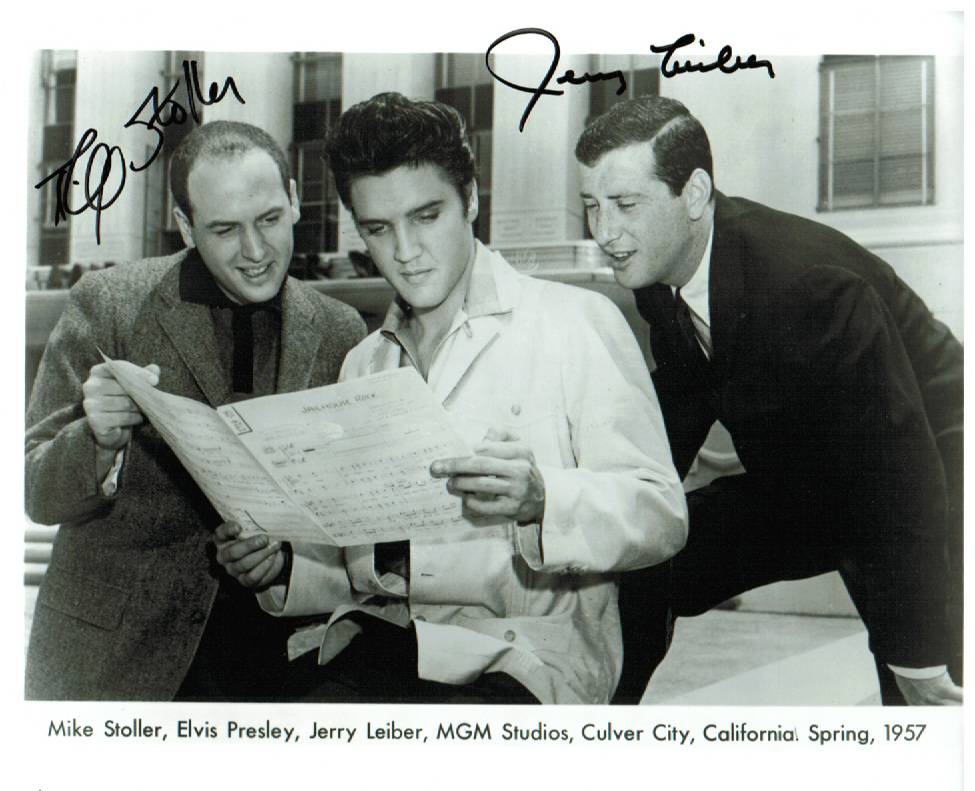 Neat to have something touched by their hands. Just another reason breakfast around here is an interesting event.
Neat to have something touched by their hands. Just another reason breakfast around here is an interesting event.
Also, I had the thought that Leiber and Stoller had the perfect kind of fame: anonymous to the public and renowned among the cognoscenti.
Garden, chickens, bees
It’s a very foggy August here in the East Bay, and I think the red mulch is really helping the garden to flourish. I have a tomato jungle with many green and some ripe tomatoes, corn almost ready to eat, baby eggplants and artichokes, squash (always a plethora of those) and cucumbers.
Plus, the chickens should be just about ready to lay. I was given an Americana rooster, named Malawi, by a family who couldn’t keep him, and so far the neighbors are okay with him. I added herbs and fake eggs (chickens like to lay their eggs next to existing ones) to the nesting box, and hung a continuous feed feeder up so that they can eat to their hearts’ content, all in preparation for eggs.
The chickens were a little spooked by the new feeder at first, but soon got used to it.
On a sad note, though, the bees have failed to thrive. I’ve been noticing their numbers diminishing, and yesterday looked in the hive. There were only a few dozen bees, and not much comb. The bee guru says this just happens sometimes. It’s disheartening. After the last bees live out their hospice days in the hive, I will clean it out and prepare it for a new swarm in the spring. And I’ll move it to a spot where they get more sun. Then perhaps they will do better. For now, just waiting for the wonderful sound a hen makes when she announces that she’s laid an egg! laid an egg! laid an egg!
Guess who came to dinner?
The chef made a repeat visit, which I found pretty flattering. I also invited a couple of friends whose company I enjoy—as easy to cook for five as for three. I made bruschetta with roasted baby tomatoes, a cucumber, jicama and citrus salad, a southwest chicken stew and peach crème celeste for dessert.
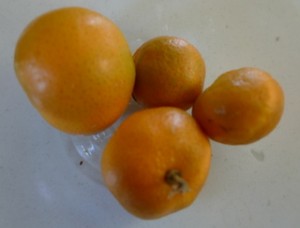
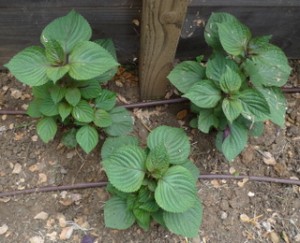
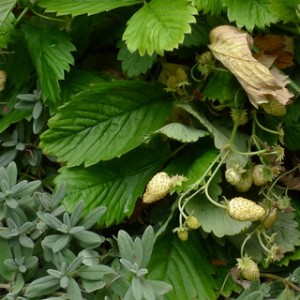 I wanted to use as many ingredients as I could that are not available commercially. This included calamondins–a small orange, Filipino lime–from my neighbor’s tree, and shiso leaves and white alpine strawberries from my garden. The chef noticed and appreciated each one—it’s so much fun to cook for someone who really tastes his food. As I made the stew the day before, I had time to play around with the salad. I put a big shiso leaf on each salad plate, and chopped some mint and shiso together to add to the vegetables. (Shiso is from the mint family and tastes slightly minty.) I sliced the cucumbers and jicama on the mandoline, and made some long cucumber slices, added some sliced orange pepper, pink grapefruit sections and a chunks of ripe peach, and sprinkled it with black sesame seeds. I used the long thin slices to make a cucumber bow on top, with a nasturtium leaf and a leaf of orange mint. I made a citrus vinaigrette with calamondin and grapefruit juice, champagne vinegar, olive oil and a little sugar.
I wanted to use as many ingredients as I could that are not available commercially. This included calamondins–a small orange, Filipino lime–from my neighbor’s tree, and shiso leaves and white alpine strawberries from my garden. The chef noticed and appreciated each one—it’s so much fun to cook for someone who really tastes his food. As I made the stew the day before, I had time to play around with the salad. I put a big shiso leaf on each salad plate, and chopped some mint and shiso together to add to the vegetables. (Shiso is from the mint family and tastes slightly minty.) I sliced the cucumbers and jicama on the mandoline, and made some long cucumber slices, added some sliced orange pepper, pink grapefruit sections and a chunks of ripe peach, and sprinkled it with black sesame seeds. I used the long thin slices to make a cucumber bow on top, with a nasturtium leaf and a leaf of orange mint. I made a citrus vinaigrette with calamondin and grapefruit juice, champagne vinegar, olive oil and a little sugar.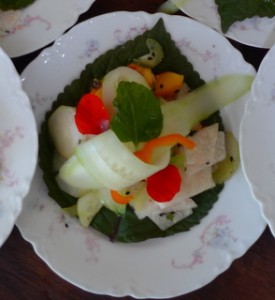
For the southwest chicken stew, I cooked some garbanzos in chicken stock the night before, adding some tomato, onion, a chipotle pepper and garlic. When they were done, I drained off the broth, and pureed the chipotle, garlic and tomato with some leftover roasted cauliflower and added these back into the broth to thicken it I bit. In my grill pan, I grilled chicken breast and merguez sausages in chunks and added them to the broth, along with some calamondin and orange juice. Then I sautéed onions, garlic, turmeric, chili flakes and some squash and threw those in with some grilled corn and chopped Romano beans. I let this simmer about half an hour, added some salt and a spoonful of lime infused honey. I put the garbanzos back in, added some chopped shiso, and and let it all cool in the fridge till an hour before dinner. If there had been a layer of fat, I would have removed it, but there was no need to defat, as there wasn’t much fat in it. I reaheated slowly, and made the salad while it heated. 
The crème celeste is a simple cream, yoghurt, sugar and gelatin dessert. I added one small, peeled and pureed peach and served with peaches simmered in sugar and brandy and topped with the alpine strawberries.
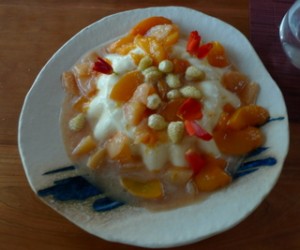 The wine, the food, and the conversation were all a delight. This was an easy meal, and lots of fun to make, especially the salad. The leftover chicken stew was also delicious. There wasn’t any leftover salad or dessert, not even a cucumber slice for the chickens.
The wine, the food, and the conversation were all a delight. This was an easy meal, and lots of fun to make, especially the salad. The leftover chicken stew was also delicious. There wasn’t any leftover salad or dessert, not even a cucumber slice for the chickens.
A pint of plain…
In the rarified intellectual world of boarding school, I arrived as a naïf in 10th grade. I was lucky to make a friend who later became a translator of Octavio Paz. He was always willing to explain a poem or a line to me. I remember clearly asking him to explain several passages of Prufrock when I first read it. What did it mean to “prepare a face to meet the faces that you meet”? And his answer—”That one’s so easy—it means to put on the mask you wear in public.”
He had a scathing wit, and for a few years after high school he was the secretary for our classes alumni notes section. He kept in touch with many alums, and his descriptions were not always kind. They were always fun to read, though. Unfortunately, the more sensitive of my classmates were offended, and he was asked to resign, which he did.
 All of which brings me to the criticism of William Logan, whom I’ve mentioned briefly before. Most poetry criticism reads like a sanitized version of alumni notes—bland, kind, praising small achievements. The world of poetry is a small and cozy one, and few want to risk alienating their peers. But in the midst of this vapid sea of faint praise, there is an island of acerbic wit called William Logan. Though he writes and publishes verse, he seems to have no qualms about pricking the pretensions of the most lauded poets, and the poetry establishment itself. Here’s an excerpt from his 2009 review of Billy Collins’ book, Ballistics:
All of which brings me to the criticism of William Logan, whom I’ve mentioned briefly before. Most poetry criticism reads like a sanitized version of alumni notes—bland, kind, praising small achievements. The world of poetry is a small and cozy one, and few want to risk alienating their peers. But in the midst of this vapid sea of faint praise, there is an island of acerbic wit called William Logan. Though he writes and publishes verse, he seems to have no qualms about pricking the pretensions of the most lauded poets, and the poetry establishment itself. Here’s an excerpt from his 2009 review of Billy Collins’ book, Ballistics:
“When comedians stop being funny, they must invent themselves anew or retire for good. A number of poems here mention divorce in a roundabout way… Indeed, the most hilarious poem in the book is titled “Divorce,” and it’s also the shortest:
Once, two spoons in bed,
now tinned forks
across a granite table
and the knives they have hired.
If Collins can become the bitter philosopher of such lines, there’s hope yet. Otherwise, Poetry must do what Poetry does when a poet runs out of gas, or screws the pooch, or jumps the shark—give him a Pulitzer and show him the door.”[1]
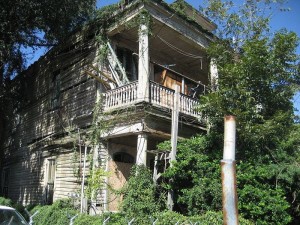 Lucille Clifton used to say “Poetry is a house of many rooms,” meaning that there is room for a wide variety of style and form. But unlike a house, whose builders need to demonstrate a minimal level of carpentry skill for the house to stand, anyone at all can claim to be a poet, whether skilled or not. Here’s where knowledgeable critics help. William Logan, Dana Gioia, and Robert Hass have each written some wonderful prose about poetry and are all worth reading. Dana Gioia’s essay “The Successful Career of Robert Bly” in Can Poetry Matter? is one of my favorites of his work. Robert Hass’s collections of newspaper columns, Now and Then, and Poet’s Choice are both worth owning, and if you like these, you might want to go on to the more difficult Twentieth Century Pleasures. But no one makes me laugh as reliably as William Logan, and that’s worth a lot in this world of woe.
Lucille Clifton used to say “Poetry is a house of many rooms,” meaning that there is room for a wide variety of style and form. But unlike a house, whose builders need to demonstrate a minimal level of carpentry skill for the house to stand, anyone at all can claim to be a poet, whether skilled or not. Here’s where knowledgeable critics help. William Logan, Dana Gioia, and Robert Hass have each written some wonderful prose about poetry and are all worth reading. Dana Gioia’s essay “The Successful Career of Robert Bly” in Can Poetry Matter? is one of my favorites of his work. Robert Hass’s collections of newspaper columns, Now and Then, and Poet’s Choice are both worth owning, and if you like these, you might want to go on to the more difficult Twentieth Century Pleasures. But no one makes me laugh as reliably as William Logan, and that’s worth a lot in this world of woe.
If you’re looking for biting wit, for someone who can pierce the veil of pretentious obfuscation poets so often draw about themselves, a pint of Wm. Logan is your only man. I’d rather be skewered by him, and have my eyes opened to what’s flabby and phony in my work than be praised by a thousand fans. But I wouldn’t have fired my friend as secretary to our class, either.
A penny for your prayer
I really try to ignore the political scene. It’s just too depressing, and like the changing of time for Daylight Savings and back, feels totally outside my control. But after reading today about prayer breakfasts on Capitol Hill, I felt moved to compose this:
Prayer’s a very private thing—
a scouring of the soul, a reckoning,
a probing of just what is meant,
a clarifying of intent.
And anyone I’ve seen to pray
in any kind of public way
who makes a show of piety,
advertises their propriety,
shows up, on examination
to be a card-carrying member
of the hypocrite nation.
 Larry, on reading it, shrugged and said “too unsubtle,” and came up with a pithier, more succinct version:
Larry, on reading it, shrugged and said “too unsubtle,” and came up with a pithier, more succinct version:
If it’s public it ain’t a prayer.
It’s bon mots like this that keep those gourmet meals coming.
In the same NY Times article, they referenced David Orr’s selection of poems to assign to Congress. Here are two I’d choose:
Sailing to Byzantium by Wm. Yeats
Cantatrice by John Berryman. As I can’t find this online, here it is, Dream Song #233
Misunderstanding. Misunderstanding, misunderstanding.
Are we stationed here among another thing?
Sometimes I wonder.
After the lightning, this afternoon, came thunder:
the natural world makes sense: cats hate water
and love fish.
Fish, plankton, bats’ radar, the sense of fish
who glide up the coast of South America
and head for Gibraltar.
How do they know it’s there? We call this instinct
by which we dream we know what instinct is,
like misunderstanding.
I was soft on a green girl once and we smiled across
and married, childed. Never did we truly take in
one burning wing.
Henry flounders. What is the name of that fish?
So better organized than we are oh.
Sing to me that name, enchanter, sing!
* * *
How about that for a prayer?
Movie, garden, poetry
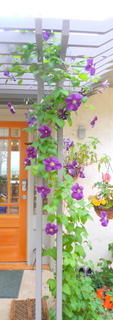 This clematis lived in a pot for five years and is finally in the ground, thriving. It almost died several times, and I wasn’t sure it would make it after the final transplant–it was just a bundle of brown sticks. My landscaper friend said it had no chance. Now it looks better than it ever did in its original home. I love to see it as I come in and out of my house–a reminder not to give up too easily, no matter what the experts say.
This clematis lived in a pot for five years and is finally in the ground, thriving. It almost died several times, and I wasn’t sure it would make it after the final transplant–it was just a bundle of brown sticks. My landscaper friend said it had no chance. Now it looks better than it ever did in its original home. I love to see it as I come in and out of my house–a reminder not to give up too easily, no matter what the experts say.
This week has been full of events regarding the movie that was partially shot at my house. I got to meet one of my favorite celebrities (and give her a poem), finally got to make dinner for the chef, and am going to be an extra in a scene.
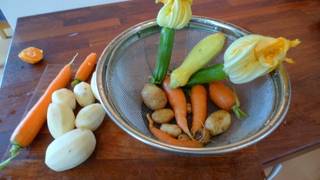
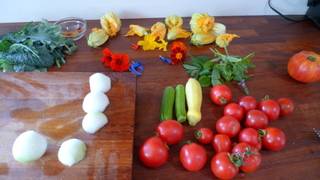 For dinner Larry suggested brisket–something tried and true. It was a hit. Brisket is something not usually on the menu in restaurants, and this one was chock full of vegetables from the garden. I used some tomatoes in the broth for the brisket, and made the rest into a very simple tomato and onion salad, with a light dressing, spread on a plate. We also had squash blossoms redux–without halibut roe.
For dinner Larry suggested brisket–something tried and true. It was a hit. Brisket is something not usually on the menu in restaurants, and this one was chock full of vegetables from the garden. I used some tomatoes in the broth for the brisket, and made the rest into a very simple tomato and onion salad, with a light dressing, spread on a plate. We also had squash blossoms redux–without halibut roe.
I started the brisket the night before. It’s always better the next day. A friend who also came for dinner asked for the recipe, and the chef himself asked a lot of questions about how I made it. I do it slightly differently each time, but here’s the general technique.
2-4 lb brisket
flour, salt. pepper
vegetable oil
pkg dried onion soup
garlic, onions, (leeks or shallots if you like)
stock or bouillon
tomatoes, potatoes
carrots, mushrooms, squash, greens, etc.
herbs, spices and other additions to taste
Prep time: 30 minutes (after meat is room temp, includes chopping veges)
Cooking time: 3+ hours
Trim off as much fat as you can and rinse the meat. Let it come to room temperature. Pat it dry if it hasn’t dried thoroughly. Drench with flour mixed with a bit of salt and pepper.
Heat oven to 350 degrees. Add enough oil to cover the bottom of your roasting pan and heat it on top of the stove till the oil is hot. Sear both sides of the brisket till brown–about five minutes a side. Turn the heat down a bit and add crushed garlic and onion wedges and let them brown. Add a handful of chopped tomatoes and a few potato chunks. Cook for a few minutes and cover the mixture with stock (beef or chicken stock will do). The stock should almost cover the meat. You can add a packet of dry onion soup mix (if you use this, sprinkle on top of the meat) a little sugar or some chopped ripe fruit, herbs, a chipotle or other hot pepper–whatever you like for flavor and sweetness.
Set the pan uncovered in the oven for at least 2 hours, until a fork goes easily into the meat, but you can’t cut the meat with a fork. Take out of the oven and let cool.
 The liquid will be really greasy. You can either cool overnight in the fridge and peel off the congealed fat or strain and degrease with something like this. In any case, after you degrease the liquid, strain out the cooked veges if you haven’t already, and blend them up and return them to the broth–this acts as a natural thickener. Add all the other vegetable chunks you want–carrots, parsnips, potatoes, cauliflower. Cook in the oven at 350 (or simmer on top of the stove) for about an hour. Now you should be able to cut the meat with a fork. Add any faster cooking veges like celery or zucchini and herbs like parsely, sage, rosemary, and cook for about 15 more minutes. Throw in final greens like chopped kale or spinach, and salt and pepper if necessary. You can refrigerate and reheat at any point in the process.
The liquid will be really greasy. You can either cool overnight in the fridge and peel off the congealed fat or strain and degrease with something like this. In any case, after you degrease the liquid, strain out the cooked veges if you haven’t already, and blend them up and return them to the broth–this acts as a natural thickener. Add all the other vegetable chunks you want–carrots, parsnips, potatoes, cauliflower. Cook in the oven at 350 (or simmer on top of the stove) for about an hour. Now you should be able to cut the meat with a fork. Add any faster cooking veges like celery or zucchini and herbs like parsely, sage, rosemary, and cook for about 15 more minutes. Throw in final greens like chopped kale or spinach, and salt and pepper if necessary. You can refrigerate and reheat at any point in the process.
And on another note, here’s the poem I was lucky enough to give to one of my favorite actresses:
Split Screen
In the media room, two movies
stream by from different cubes:
one the birth of skateboarding,
the other a sixties Cassavetes’ flick.
He and his pals caper in trench coats and sideburns,
troubled and frantic and utterly honorable,
eyebrows cocked
and ready to fire. Even without sound,
you can tell the dialog is urbane.
All the streets are grey.
While the insouciant Z-boys of Dogtown glide,
neon in their t-shirts and sunbleached hair,
impossibly graceful and doomed and obsessed,
defining what the body can do in air
as they careen into myth
and the boys become brands.
Whatever else we’ve done
at whatever cost,
we’ve given the world this:
New York angst,
California cool.
So much to read, so little time
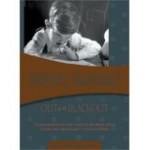 But if you’re looking for a easy-to-read mystery with a twist, try Out of the Blackout, by Robert Barnard, which I learned about from Harriet Devine’s blog–a terrific resource. In this well-paced and unusual story the murder may or may not have happened, but doesn’t enter in till the middle of the suspense. It starts as an extra boy appears in a group of evacuees from London during the blitz. About five years old, the boy calls himself Simon Thorn. No one ever claims him, and his origins remain mysterious until he investigates them himself as an adult.
But if you’re looking for a easy-to-read mystery with a twist, try Out of the Blackout, by Robert Barnard, which I learned about from Harriet Devine’s blog–a terrific resource. In this well-paced and unusual story the murder may or may not have happened, but doesn’t enter in till the middle of the suspense. It starts as an extra boy appears in a group of evacuees from London during the blitz. About five years old, the boy calls himself Simon Thorn. No one ever claims him, and his origins remain mysterious until he investigates them himself as an adult.
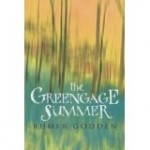 And Harriet’s blog (featuring Rumer Godden at the moment) reminded me how much I love Greengage Summer, the story of a family stranded at a hotel in southern France for a summer, due to their mother’s falling seriously ill on the journey. The children fend for themselves, and the two oldest girls each come of age in their own way. A perfect summer read. This is her best book, I think, though she and her sister Jon wrote a number of readable novels.
And Harriet’s blog (featuring Rumer Godden at the moment) reminded me how much I love Greengage Summer, the story of a family stranded at a hotel in southern France for a summer, due to their mother’s falling seriously ill on the journey. The children fend for themselves, and the two oldest girls each come of age in their own way. A perfect summer read. This is her best book, I think, though she and her sister Jon wrote a number of readable novels.
Is there anything better than reading in a hammock on a hot summer afternoon? Which reminds me of of another favorite, this James Wright poem:
Lying in a Hammock at William Duffy’s Farm in Pine Island Minnesota
Over my head, I see the bronze butterfly,
Asleep on the black trunk,
blowing like a leaf in green shadow.
Down the ravine behind the empty house,
The cowbells follow one another
Into the distances of the afternoon.
To my right,
In a field of sunlight between two pines,
The droppings of last year’s horses
Blaze up into golden stones.
I lean back, as the evening darkens and comes on.
A chicken hawk floats over, looking for home.
I have wasted my life.
James Wright
You can hear him read it, if you like. I love the specificity of his images, and how he telescopes the process of horse droppings to fertilizer to golden wild flowers in two lines. A short poem that builds dramatically to the conclusion. Happy August!
New standards of journalism
Quiet on the set
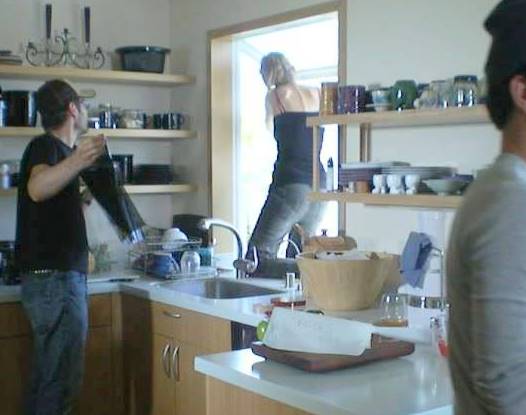 For the past week, a movie crew has been using my house and garden as a set. Here the crew is setting up my kitchen. The paper in front says “Hot Set” which meant takeout for dinner last night. I’m not allowed to give details about the movie or the actors yet, but it’s been an interesting experience to have a crew of about 18 people here each day.
For the past week, a movie crew has been using my house and garden as a set. Here the crew is setting up my kitchen. The paper in front says “Hot Set” which meant takeout for dinner last night. I’m not allowed to give details about the movie or the actors yet, but it’s been an interesting experience to have a crew of about 18 people here each day.
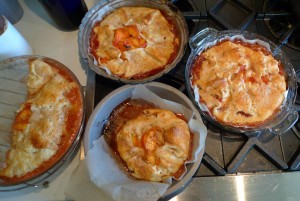 They have been as considerate as possible and while they keep telling me it’s a minimalist production, I’ve been impressed watching them haul hundreds of pounds of equipment up and down my five flights of stairs, create grass, hedges and fences, set up a complete wardrobe and makeup shop, and in general construct what they needed on site. They have lunch catered, but one day the ice tea spilled into the lemon bars, so I made some extra peach galettes. I had to bring a dessert to an event that night, so just made two extra. One got sampled before I could get out my camera!
They have been as considerate as possible and while they keep telling me it’s a minimalist production, I’ve been impressed watching them haul hundreds of pounds of equipment up and down my five flights of stairs, create grass, hedges and fences, set up a complete wardrobe and makeup shop, and in general construct what they needed on site. They have lunch catered, but one day the ice tea spilled into the lemon bars, so I made some extra peach galettes. I had to bring a dessert to an event that night, so just made two extra. One got sampled before I could get out my camera!
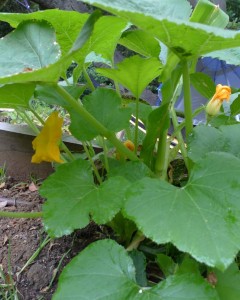 This week, one of the main actors is also a renowned chef. He was mostly in the outdoor shots, and noticed the wealth of squash blossoms. He suggested that I pick and cook them and told me how to make a filling of a mushroom duxelle, something new to me. This is basically mushrooms chopped really fine (you can do this in a food processor) and cooked in butter till the liquid evaporates and you have a sort of mushroom paste. You can add some minced shallots and thyme leaves for flavor. He also told me to flour the outside of the blossom first, then dip into beaten egg, then into panko (those spirally Japanese breadcrumbs). So I invited him to dinner. Wednesday was their last day of filming here, and yesterday they were filming in Napa. He accepted, pending their shooting schedule, and I busied myself making the squash blossoms, some lightly grilled cherry tomatoes, and grilled salmon with a mango/tomato salsa.
This week, one of the main actors is also a renowned chef. He was mostly in the outdoor shots, and noticed the wealth of squash blossoms. He suggested that I pick and cook them and told me how to make a filling of a mushroom duxelle, something new to me. This is basically mushrooms chopped really fine (you can do this in a food processor) and cooked in butter till the liquid evaporates and you have a sort of mushroom paste. You can add some minced shallots and thyme leaves for flavor. He also told me to flour the outside of the blossom first, then dip into beaten egg, then into panko (those spirally Japanese breadcrumbs). So I invited him to dinner. Wednesday was their last day of filming here, and yesterday they were filming in Napa. He accepted, pending their shooting schedule, and I busied myself making the squash blossoms, some lightly grilled cherry tomatoes, and grilled salmon with a mango/tomato salsa.
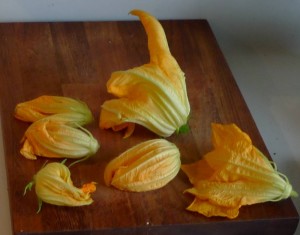 For the blossoms, in addition to the mushroom duxelle (yummy!), I had some halibut roe from the Farmers’ Market. I sauteed the roe with chopped onion from the garden, fresh tumeric, ginger and garlic and a little diced celery. My idea was to see if he could guess what the filling was. It’s a very subtle flavor and a light fluffy texture, almost like beaten egg whites. The roe are much smaller than caviar, and if you chop into the skin that holds them, they smoosh out into a light pasty substance. I wish I’d taken a picture when it was in the skin, as it’s unique, but here it is after cooking it up:
For the blossoms, in addition to the mushroom duxelle (yummy!), I had some halibut roe from the Farmers’ Market. I sauteed the roe with chopped onion from the garden, fresh tumeric, ginger and garlic and a little diced celery. My idea was to see if he could guess what the filling was. It’s a very subtle flavor and a light fluffy texture, almost like beaten egg whites. The roe are much smaller than caviar, and if you chop into the skin that holds them, they smoosh out into a light pasty substance. I wish I’d taken a picture when it was in the skin, as it’s unique, but here it is after cooking it up:
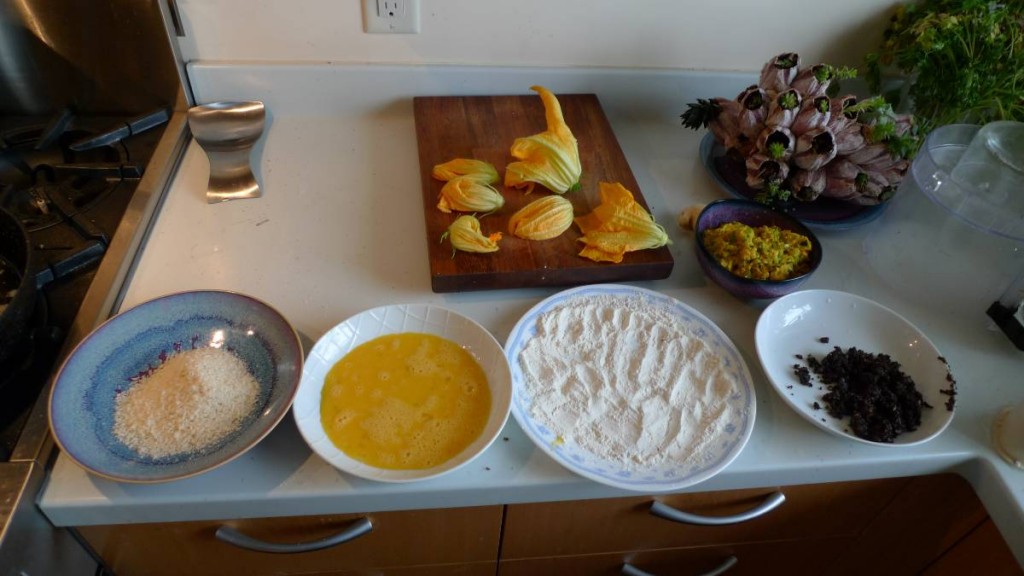 I got everything ready, but then got a call that filming was running very late, and we’d have to reschedule. Luckily, some good friends were available on short notice to come eat with us:
I got everything ready, but then got a call that filming was running very late, and we’d have to reschedule. Luckily, some good friends were available on short notice to come eat with us:
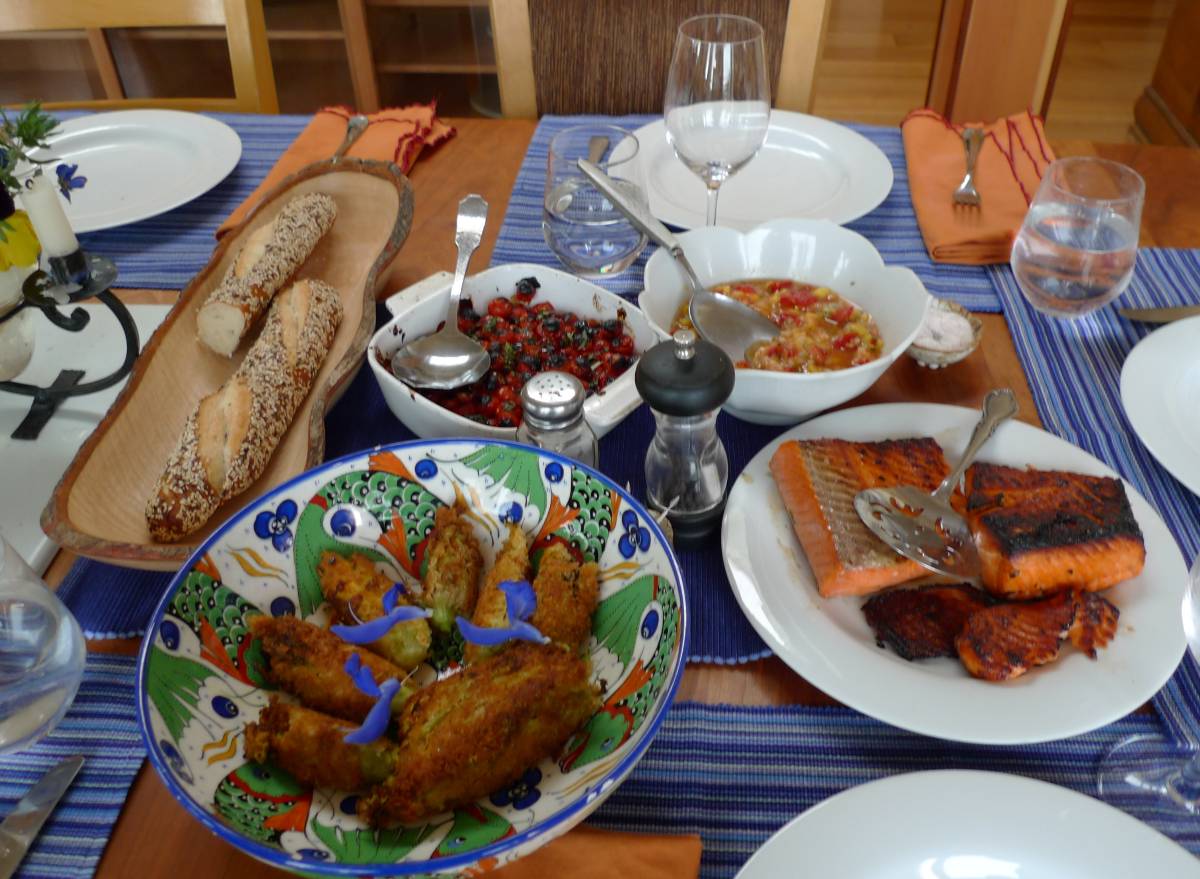 I threw on a few sage flowers to brighten them and the squash blossoms were delicious! If we reschedule, I’ll have to think of what else to make.
I threw on a few sage flowers to brighten them and the squash blossoms were delicious! If we reschedule, I’ll have to think of what else to make.
Fran Landesman
 Today, Larry passed me Fran Landesman’s obit. Born in 1927, she knew Kerouac and Ginsberg, and Lenny Bruce once asked her to leave her husband and run off with him, saying: “Let’s you and me go on the road and send him a little money every month.” But my favorite part was how she took the line “April is the cruelest month,” from “The Wasteland” and turned it into the jazz standard “Spring Can Really Hang You Up the Most.”
Today, Larry passed me Fran Landesman’s obit. Born in 1927, she knew Kerouac and Ginsberg, and Lenny Bruce once asked her to leave her husband and run off with him, saying: “Let’s you and me go on the road and send him a little money every month.” But my favorite part was how she took the line “April is the cruelest month,” from “The Wasteland” and turned it into the jazz standard “Spring Can Really Hang You Up the Most.”
Curated art vs. the artist’s garage
This week we saw two shows currently on view in San Francisco, “Picasso Masterpieces from the Musée National Picasso, Paris” at the de Young, and “The Steins Collect,” at SF MOMA. The first was a disappointment. A mishmash of Picasso pieces owned by the artist and left to the French government at his death, it seemed to me to be a large selection of whatever people hadn’t bought when Picasso was alive. There were a few wonderful pieces, but mostly I was reminded that once someone is famous, anything they make or do goes on display, including a lot of the necessarily failed sketches and paintings one must make to come up with the few stunning works of art.
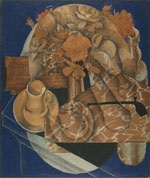 In contrast, the collections of Leo and Gertrude Stein and their brother Michael and his wife Sarah compose a thoughtfully curated collection, purchased largely before the artists became famous. It’s a stunning exhibit that features early works by Picasso, Matisse, Manguin, Gris, and others. The collection was arranged in groups by who collected the paintings and when they were collected, and the blurbs provided context for each room. It is one of the few exhibits in which the text actually added to the paintings. There were also photographs of the Steins and of the paintings as they hung in Paris. My favorites were this Juan Gris collage (you can hear a brief audio snippet if you click the picture to the left), and most of all, La Coiffure by Henri Manguin. This is a luminous and moving painting, and I want to go back and look at it again. As the Steins bought it in 1906 and hung it in their famous studio, both Picasso and Matisse saw it and did their own versions, but I loved this one by Manguin (a painter I’d never heard of before). This image can’t capture the idea:
In contrast, the collections of Leo and Gertrude Stein and their brother Michael and his wife Sarah compose a thoughtfully curated collection, purchased largely before the artists became famous. It’s a stunning exhibit that features early works by Picasso, Matisse, Manguin, Gris, and others. The collection was arranged in groups by who collected the paintings and when they were collected, and the blurbs provided context for each room. It is one of the few exhibits in which the text actually added to the paintings. There were also photographs of the Steins and of the paintings as they hung in Paris. My favorites were this Juan Gris collage (you can hear a brief audio snippet if you click the picture to the left), and most of all, La Coiffure by Henri Manguin. This is a luminous and moving painting, and I want to go back and look at it again. As the Steins bought it in 1906 and hung it in their famous studio, both Picasso and Matisse saw it and did their own versions, but I loved this one by Manguin (a painter I’d never heard of before). This image can’t capture the idea:
 (Image now flipped correctly, thanks to a perspicacious reader!) It was interesting to read about Leo, Gertrude, Michael and Sarah. The latter couple really introduced Matisse to the US. If you have a chance between now and September 6, I highly recommend a visit to SF MOMA so you can see for yourself. They make a delicious cappuccino on the roof garden, too.
(Image now flipped correctly, thanks to a perspicacious reader!) It was interesting to read about Leo, Gertrude, Michael and Sarah. The latter couple really introduced Matisse to the US. If you have a chance between now and September 6, I highly recommend a visit to SF MOMA so you can see for yourself. They make a delicious cappuccino on the roof garden, too.

